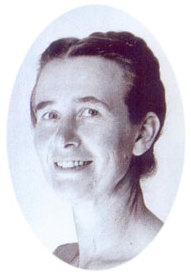Erica Deichmann Gregg facts for kids
Erica Deichmann Gregg CM (born Matthiesen; 23 July 1913 – 21 May 2007) was a talented Canadian studio potter. A studio potter is an artist who makes pottery by hand in their own workshop. In the 1930s, Erica and her first husband, Kjeld Deichmann, started Deichmann pottery. This was Canada's very first studio pottery business.
Contents
Early Life and Family
Erica Luisa Matthiesen was born on July 23, 1913, in Denmark, Wisconsin, in the United States. She was one of five daughters. Her father was a Danish Lutheran pastor, which is a type of Christian minister.
When Erica was seven years old, her family moved back to Denmark. She spent her childhood years growing up there. Later, in the late 1920s, her family moved to Canada. They settled in Edmonton, a city in Canada. It was there that she met Kjeld Deichmann, who was also an immigrant from Denmark.
Erica married Kjeld Deichmann in 1932. Their wedding took place in Saint John, New Brunswick. After they were married, they made their home on a farm. This farm was located on the Kingston Peninsula, which is near Saint John.
Artistic Career
Learning and Starting the Studio
After they got married, Erica and Kjeld spent a year traveling in Europe. During this time, Kjeld learned about pottery. He worked with a potter named Axel Brüel and even helped him build a special oven called a kiln. A kiln is used to bake clay and make it hard. Erica also studied weaving during their trip.
When they returned to New Brunswick, they set up their own pottery studio. They built it right at their home. They named their studio "Dykelands." This name came from the small dykes (low walls or banks) that were on their property. In 1935, Kjeld built a wood-burning kiln. They used this kiln for their very first pottery firing.
Experimentation and Creativity
The Deichmanns mostly taught themselves how to make pottery. They learned by trying new things all the time. They experimented with how to design their kiln, what kind of clay to use, and how to make different glazes. Glazes are the shiny, often colorful, coatings on pottery.
Erica was especially good at creating glazes. She made more than 5,000 different experimental mixtures during her time as a potter. She also decorated the pottery. She usually painted on the soft, raw clay before it was baked in the kiln. Erica also made fun, tiny animal shapes by hand. She called these little sculptures "goofi."
Moving and Closing the Studio
In 1956, the Deichmanns moved their pottery studio. They relocated it to Sussex, New Brunswick. Sadly, Kjeld Deichmann passed away suddenly in June 1963. After her husband's death, Erica decided to close the studio. She stopped making pottery at that time.
Later Life and Recognition
In 1964, Erica married Milton Fowler Gregg. He was a Canadian war hero, a politician, and a diplomat. After their marriage, she became known as Erica Deichmann Gregg.
Erica was recognized for her important contributions. In 1987, she was named a member of the Order of Canada. This is one of the highest honors a Canadian citizen can receive. The award recognized her as an "influential, international award-winning potter." It also noted her active volunteer work. She volunteered for many groups, including:
- The Society for the Preservation of New Brunswick's Covered Bridges
- The Beaverbrook Art Gallery
- The Conservation Council of New Brunswick
- The Critical Natural Areas of New Brunswick Project
In May 1992, the University of New Brunswick honored her even more. They gave her an honorary Doctor of Letters degree.
Erica Deichmann Gregg passed away in Hampton, New Brunswick, on May 27, 2007. She and Kjeld Deichmann had one son and two daughters. One of their daughters is the well-known novelist and poet, Elisabeth Harvor.


